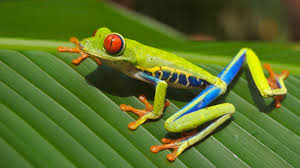Frogs are fascinating amphibians that inhabit diverse ecosystems worldwide. With over 5,000 species, they exhibit a remarkable range of behaviors, adaptations, and ecological roles. This article delves into the world of frogs, exploring their characteristics, habitats, behaviors, and the challenges they face.

What Are Frogs?
Frogs are amphibians belonging to the order Anura, characterized by their jumping abilities, bulging eyes, and permeable skin. They undergo a unique life cycle, starting as aquatic larvae (tadpoles) and metamorphosing into terrestrial adults. This dual life cycle is a defining feature of amphibians.
Physical Characteristics
Size and Coloration: Frogs vary significantly in size, from the tiny Paedophryne amauensis, measuring just 7.7 mm, to the Goliath frog, which can grow up to 32 cm in length. Their coloration ranges from vibrant greens and yellows to browns and blacks, often serving as camouflage or warning coloration.
Skin: Their skin is smooth and moist, facilitating respiration and hydration. Some species secrete toxins through their skin as a defense mechanism.
Limbs: Adapted for jumping, frogs possess strong hind legs with webbed feet, aiding in swimming and leaping.
Habitat and Distribution
Frogs inhabit every continent except Antarctica, occupying a wide range of environments from tropical rainforests to arid deserts. They are commonly found in freshwater habitats like ponds, lakes, and rivers, but some species have adapted to terrestrial or arboreal (tree-dwelling) lifestyles.
Behavior and Diet
Feeding: Frogs are primarily insectivorous, using their long, sticky tongues to capture prey. Some larger species may consume small vertebrates, including other frogs.
Reproduction: During mating seasons, males produce distinctive calls to attract females. These calls vary among species and can be heard from great distances. After mating, females lay eggs in water, which hatch into tadpoles before undergoing metamorphosis into adult frogs.
Activity Patterns: Many frogs are nocturnal, becoming active at night to feed and breed, which helps them avoid daytime predators and the drying effects of the sun.
Interesting Facts
Communication: Frogs communicate through vocalizations, body movements, and visual signals. Some species have specialized calls for attracting mates, warning of predators, or defending territory.
Defense Mechanisms: Certain frogs have developed unique defense strategies, such as secreting toxins, inflating their bodies to appear larger, or using camouflage to blend into their surroundings.
Regenerative Abilities: Some frog species can regenerate lost limbs, a trait that has been a subject of scientific research for its potential applications in medicine.
Conservation Status
Many frog species are facing threats from habitat loss, climate change, pollution, and diseases like chytridiomycosis. Conservation efforts are underway globally to protect these amphibians, including habitat restoration, breeding programs, and research on disease management.
Frogs are integral components of ecosystems, serving as both predators and prey, and playing vital roles in nutrient cycling and pest control. Their diverse adaptations and behaviors make them subjects of scientific interest and cultural significance. Protecting frogs and their habitats is essential for maintaining biodiversity and ecological balance.
Faqs
What are frogs?
Frogs are amphibians belonging to the order Anura, characterized by their jumping abilities, bulging eyes, and slimy skin. They are found worldwide, inhabiting various ecosystems from tropical rainforests to arid deserts. citeturn0search6
How many species of frogs exist?
There are over 6,000 known species of frogs, making them one of the most diverse groups of vertebrates. citeturn0search6
What is the life cycle of a frog?
Frogs undergo a four-stage life cycle:
1. Egg: Laid in water, these hatch into tadpoles.
2. Tadpole: Aquatic larvae with gills.
3. Juvenile: Development of legs and lungs.
4. Adult: Fully developed frog capable of reproduction.
This transformation is known as metamorphosis.
What do frogs eat?
Frogs are primarily insectivores, feeding on insects, spiders, and other small invertebrates. Larger species may consume small vertebrates like fish or other amphibians.
How do frogs communicate?
Frogs communicate using vocalizations, especially during mating seasons. Each species has a unique call used to attract mates or establish territory.
Are frogs endangered?
Yes, many frog species are threatened or endangered due to habitat loss, pollution, climate change, and diseases like chytridiomycosis. Conservation efforts are ongoing to protect these amphibians.
How do frogs breathe?
Frogs breathe through their lungs and skin. Some species can absorb oxygen through their skin, a process known as cutaneous respiration.
What is the difference between frogs and toads?
While both are amphibians, frogs typically have smooth, moist skin and longer legs adapted for jumping. Toads usually have dry, bumpy skin and shorter legs, making them less agile jumpers.
How do frogs reproduce?
Frogs lay eggs in water, which hatch into tadpoles. As tadpoles mature, they undergo metamorphosis, developing legs and lungs, and eventually become adult frogs capable of reproduction.
Can frogs live on land?
Yes, adult frogs are primarily terrestrial but return to water to breed. Some species are more aquatic, while others are adapted to live on land.
How do frogs protect themselves from predators?
Frogs employ various defense mechanisms, including camouflage, toxic skin secretions, and the ability to leap away quickly.
What is the largest frog species?
The Goliath frog (Conraua goliath) is the largest frog species, native to West Africa. It can grow up to 12.5 inches (32 cm) in length and weigh over 3 kg (7 lbs).
Do frogs have teeth?
Yes, frogs have small teeth in their upper jaw, which they use to hold onto prey. They do not chew their food; instead, they swallow it whole.
How long do frogs live?
The lifespan of a frog varies by species. Some frogs live only a few years, while others can live over a decade in the wild.
Are frogs cold-blooded?
Yes, frogs are cold-blooded (ectothermic), meaning their body temperature is regulated by the environment.
To read more click here

Leave a Reply